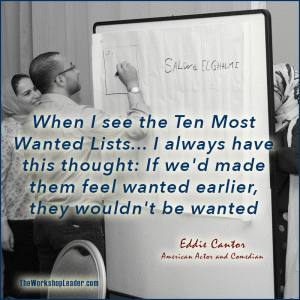When I see the Ten Most Wanted Lists… I always have this thought: If we’d made them feel wanted earlier, they wouldn’t be wanted now.
Eddie Cantor (1892–1964)
American actor and comedian
Ever seen yourself on a Wanted Poster? Then, it’s high time to do so — with all the relevant information. Get the feeling of being special and wanted. So, you won’t end up on a real wanted poster.
This is an icebreaker activity to familiarize participants with each other. The form of the wanted poster reduces information to the relevant and the time needed.
As workshop leader you can oberserve during the preparation time the participants’ skills in working with workshop material like posters, boards, markers etc. and their time discipline.
Objective of Wanted Poster

Presentation of participants.
Resources
Markers and flip chart sheets.
Time
2 x 8 minutes interviews plus sketching time, plus 3 mins per participant presentation.
Task
Make teams of two who interview each other and draw a Wanted Poster. It’s recommended to mix gender, organisation, and age groups. After 5—8 minutes give a signal to switch the direction of the interview. After 15—16 minutes, the team of two presents each other to the rest of the group.
As in a real Wanted Poster they should reveal important points:
- A picture — let’s sketch it!
- A reason why the police are searching for him or her.
- A description including age, height, weight, sex, eye colour.
- A distinctive feature: e.g. scar on cheek, permanently using his mobile phone.
- A warning: e.g. dangerous as very charming and friendly.
- A reward.
Experience shows that it is very helpful to attach the posters to the wall of the workshop room. Thus, you can remember or refer to single participants, while new incoming facilitators get an idea of their target audience.
Phase
Wanted Poster is a classic starting game.

